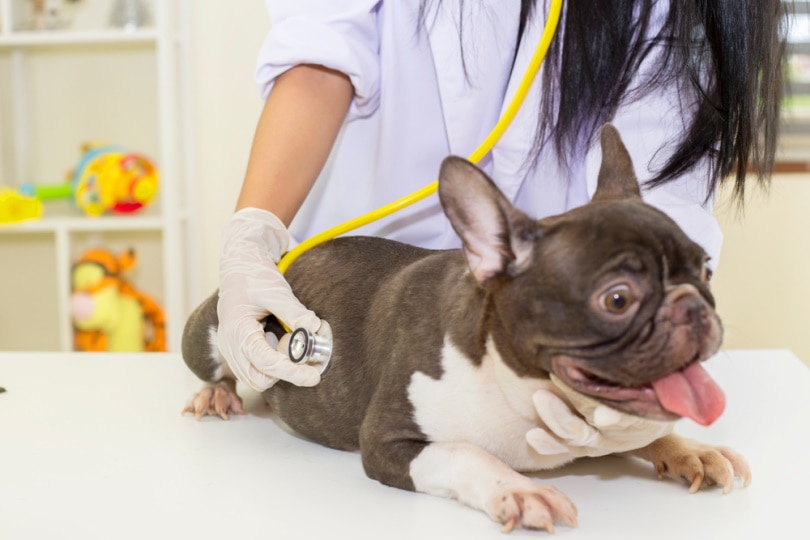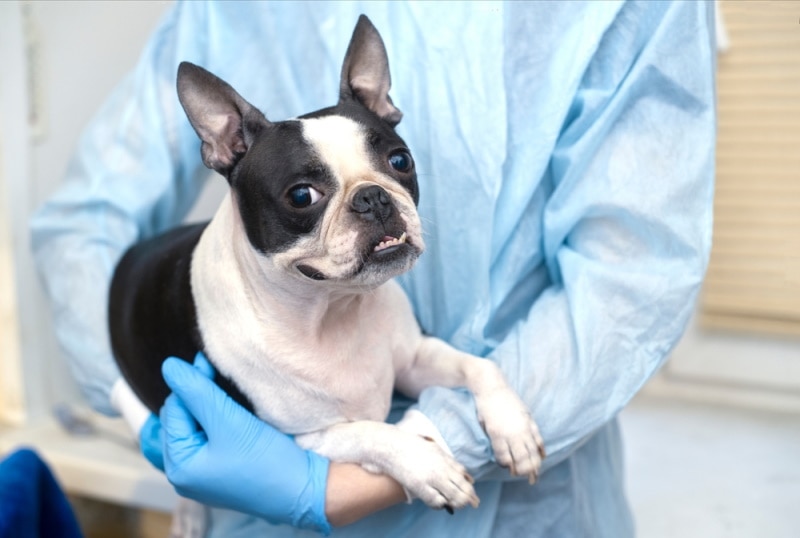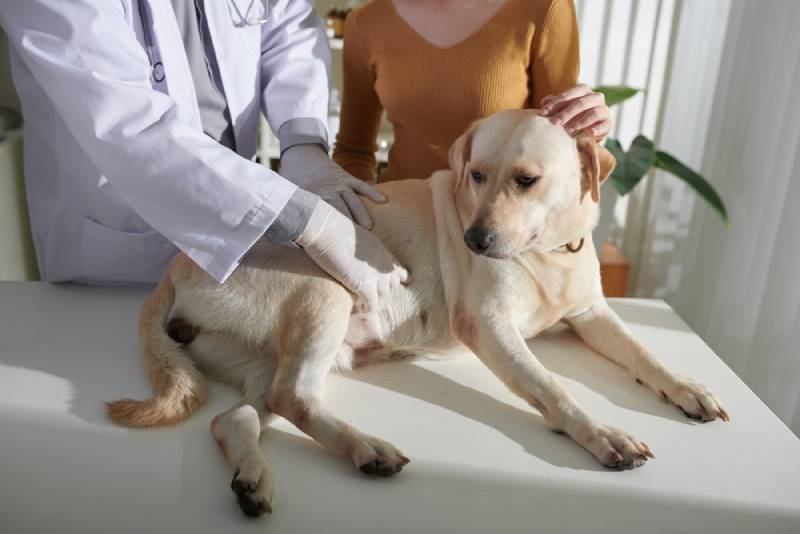Brachycephalic Airway Syndrome In Dogs: Our Vet Explains Causes, Signs & Care
Updated on

Click to Skip Ahead
Brachycephalic dogs (dogs with shortened skull bones) have become increasingly popular over the last few decades. Unfortunately, while these dogs have great personalities and make excellent additions to an urban family environment, such breeds of dogs have a higher incidence of various disease conditions. The most common is brachycephalic airway syndrome, otherwise referred to as brachycephalic obstructive airway syndrome (or BOAS).
While BOAS is primarily a problem involving the airways, it is common for it to co-exist with gastrointestinal abnormalities, such as hiatal hernia and gastroesophageal reflux disease (GERD), amongst other complications. We’ll highlight the main components of BOAS below, how it can be managed, and what else you need to be aware of in brachycephalic dogs.
What Is Brachycephalic Airway Syndrome?
If we break up the term “brachycephaly” into the words from which it is derived, it denotes “short” (brachy or brakhu) and “head” (cephaly or cephalos) or a foreshortened skull. While the term “brachycephaly” refers to the bones of the skull, the changes in the respiratory tract associated with this abnormal conformation are known as brachycephalic obstructive airway syndrome (BOAS). The anatomical abnormalities that makeup BOAS cause increased resistance to inspiratory airflow, thus affecting the passage of air with breathing. These changes involve the upper and lower respiratory tract.

What Are the Components of BOAS?
As experience with this condition has grown exponentially of late, so has our understanding of the various components that make up BOAS and contribute to the clinical signs seen in our ever-popular snub-nose friends. These components can broadly be categorized into primary and secondary abnormalities, with the latter considered a consequence of a combination of the following:
- Chronic pressure changes within the airways
- Irritation and inflammation
- Fatigue
- Death of cells or tissues of specific airway structures
- Stenotic nares – narrowed external nostrils, with a reduced diameter of the nasal vestibules (just inside the nostril) leading into the nasal cavity
- Elongated and thickened soft palate – this often overlaps the epiglottis and results in the commonly described gagging and retching reported by owners
- Enlarged tongue
- Tracheal hypoplasia – can be associated with thoracic wall and spinal deformities
- Enlarged or protruding palatine tonsils
- Pharyngeal collapse – partial or complete
- Eversion of the laryngeal saccules and laryngeal collapse
- Bronchial abnormalities – such as bronchial collapse
- Pulmonary hypertension – secondary to chronic bronchial collapse and subsequent stenosis
What Complications Are Associated With BOAS?
Unfortunately, the problem with BOAS is not limited to the respiratory tract alone and the abnormalities described above. Various complications have been identified in association with or because of BOAS.
Abnormalities of the gastrointestinal tract are the most common complication associated with BOAS. Some studies have reported a prevalence of as high as 97% of dogs with BOAS having gastrointestinal tract clinical signs or disorders. This association is unsurprising, given that the gastrointestinal and respiratory tracts share overlapping mechanisms/pathways that control swallowing and breathing.
Within this group of abnormalities are gastroesophageal reflux disease (GERD), congenital or acquired hiatal hernias, and esophageal motility disorders. Hiatal hernia refers to a prolapse of abdominal organs through the opening in the diaphragm that the esophagus passes through before continuing with the stomach and into the chest cavity. It results from abnormal pressures within the chest cavity and the esophagus.

GERD is defined as the pathological reflux of stomach and intestinal contents into the esophagus, leading to esophagitis (inflammation of the esophagus), esophageal ulceration, and, in more severe cases, esophageal stricture formation (scar tissue development).
The problem doesn’t stop there because, unfortunately, in turn, these abnormalities or conditions can precipitate further issues such as gastric dilatation-volvulus (GDV or bloat) and even aspiration pneumonia secondary to repeated bouts of regurgitation.
Another common complication associated with BOAS is sleep disorders. Other possible complications include hypoxemia leading to secondary liver disease/injury, high blood pressure, hypercoagulability (being predisposed to thromboembolic disease), and middle ear effusions (fluid in the middle ear). In severe cases, such complications can culminate in progressive, multiorgan dysfunction; in other words, the shutdown of various organ systems, leading to organ failure.
What Are the Signs of BOAS?
If we look at the components of BOAS alone, typical clinical signs can include any or all of the following, depending on the severity of the disease:
- Snoring
- Panting
- Cyanosis (blueish/purplish discoloration of the gums/mucous membranes because of a lack of oxygen)
- Exercise intolerance
- Prolonged recovery from exercise
If we start looking at a more global picture of a dog with BOAS and some of the more common complications described above, clinical signs might include:
- Retching
- Regurgitation
- Vomiting
- Dysphagia (difficulty swallowing)
- Extension of the head and neck during attempts at swallowing
- Lip-smacking
- Ptyalism (excessive drooling or salivation)
- Grass ingestion and surface licking
- Anorexia
In dogs with several or even many to most of the above clinical signs, as I’m sure you can appreciate, there can be a significant impact on their quality of life and that of their human caretakers. In more severe cases, clinical signs can progress to being life-threatening.

What Are the Causes of BOAS?
As mentioned above, the anatomic abnormalities associated with BOAS can be classified as primary or secondary. The primary abnormalities are a direct consequence of the abnormal conformation of the skull. In other words, with breeding brachycephalic dogs such as Pugs, French Bulldogs, British Bulldogs, and Boston Terriers, there is a selection for the features of having a snub-nose and thus the respiratory tract abnormalities that go with them. These dogs are born with these anatomic abnormalities to varying degrees. The secondary abnormalities result from the primary abnormalities and the changes they bring about within the airways of dogs with BOAS.
How Do I Care for a Dog With BOAS?
The main treatment is surgery. While some of the primary abnormalities listed above can be surgically improved, it can, in some cases, be difficult to decide which dogs will benefit from surgery. Such a decision is still largely subjective and is based on the severity of clinical signs.
To put things into perspective, approximately 90% of dogs with BOAS that undergo surgery have an improvement in their clinical signs. While that sounds like an impressive number, only half of these cases showing improvement are classified as having a significant improvement or considered to have an excellent outcome. About 10% of dogs will show no improvement following surgery, and it’s currently challenging to identify these patients before surgery to prevent putting them through a procedure that might not provide any benefit. Potential reasons for such a poor response include anatomical abnormalities that cannot be surgically corrected and a significant degree of irreversible secondary changes.

In addition to surgery, other forms of therapy can benefit dogs with BOAS-associated complications and help maintain an acceptable quality of life. Such treatments include medical management, changes to feeding practices, weight loss/maintenance of lean body condition, exercise restriction, and environmental modification.
Examples of medications that might be recommended are mainly for the treatment of associated gastrointestinal tract abnormalities and can include prokinetics (to enhance the motility of the gut, particularly the esophagus), proton-pump inhibitors (e.g., omeprazole; to reduce gastric acid production/secretion), and gastro protectants (such as sucralfate).
Conclusion
BOAS is a potentially life-threatening problem in flat-faced dogs. Corrective surgical management is generally recommended. Appropriate medical treatment is often needed to manage the commonly identified associated gastrointestinal diseases. Despite the combination of surgical and medical treatment, an entirely successful outcome cannot be achieved in many cases, significantly impacting the quality of life. In more severe cases, the disease can be so progressive that it leads to multiorgan dysfunction.
Featured Image Credit: Nadya Chetah, Shutterstock

















